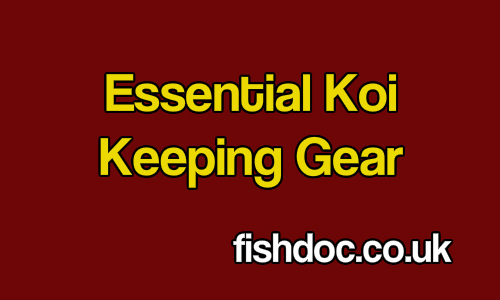Are you equipped for koi keeping?
So what sort of equipment do you need? Although it is not possible to draw up a list that covers every contingency we can list some basic equipment that every hobbyist needs to handle routine tasks and most common problems.
Water testing is an essential part of healthy koi-keeping and general fish-keeping. Regardless of what type of water test-kit is used, it is important that testing is undertaken regularly. It is also important to keep a record of the readings. This gives a documented history of the pond, showing up seasonal fluctuations, any anomalies and the possible causes of any problems. As well as the results of each test, record the date and time of day they were carried out. Testing should be carried out weekly and more often if the pond is new, medicated or disturbed in any way. The basic tests that all koi-keepers should carry out are for temperature, pH, ammonia, nitrite, dissolved oxygen, hardness and nitrate. It is worth also noting any pond treatments or introductions of fish and entering that with your measurement results into a record book. | |
It is amazing how many koi keepers do not own a proper net. We all need to catch our fish at some time. Taking a fish out of a pond is potentially hazardous and everything possible should be done to reduce the risk of stress and damage. I am all for economies where possible but whatever you do don't try to economize when buying a net, buy the best. The wrong type (too small, flexible or of poor quality materials or design) makes catching koi a stressful exercise - for both you and your fish. Worse still, it can lead to serious physical damage if fish are knocked or fins and scales are caught. The net should be a shallow-pan type of at least 24-inch diameter, with a long, firm handle that doesn't flex when the net is moved through the water. | |
Once you've panned the Koi to the side of the pond, you can transfer it easily to a Koi Sock type net. Since the whole body of the Koi is supported like a hammock, and there are no fish on top of the specimen, you can carry a large Koi in a Koi Sock net. | |
Koi should not be lifted out of the pond in a pan type net - it is to be used for confining and guiding them to the side of the pond where they should be encouraged to swim into a floating bowl or basket. These can be bought from specialist koi outlets although I have seen some effective home-made ones. A floating basket confines the koi, allowing examination without having to remove it from the pond. A koi sock-net, a long narrow net with an open bottom, makes koi handling safe and easy! If the koi has to be removed from the pond for treatment it is important to have at least two large treatment bowls. Again, these can be bought from koi specialists or, alternatively, round 25-gallon cold-water tanks can be obtained from a plumbers' merchant. Text | |
An air-pump is essential as aeration is needed with most medications. A small aquarium pump that can serve two air-stones is fine. It is bad practice to use other people's nets and bowls as this brings with it the risk of infection. | |
Even with the best-designed and managed pond there will be the occasional problem. It is no good waiting until the problem arises and then desperately running about trying to get hold of equipment and treatments. Every koi-keeper should have a basic first-aid kit, which should be kept out of reach of children. A baby's changing mat makes an ideal treatment surface for koi, being soft and less likely to remove mucus than a damp towel. | |

